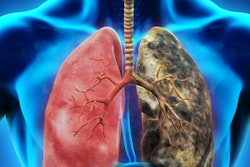
Does a higher number of lung nodules detected on baseline CT screens indicate an increased risk of cancer? Researchers with the Dutch-Belgian Randomized Lung Cancer Screening (NELSON) trial refute this notion in a study published in the November issue of Lung Cancer.
After evaluating baseline CT scans from the NELSON trial, the researchers found that approximately 50% of lung cancer participants present with at least one noncalcified pulmonary nodule and a quarter of screening participants have at least two.
The probability of developing lung cancer does not change with differing nodule counts in participants with at least one nodule, Dr. Marjolein Heuvelmans from the University Medical Center Groningen in the Netherlands told AuntMinnie.com via email.
"Baseline nodule count proved not to be useful for prediction of malignancy," she said. "Each nodule found in lung cancer screening subjects should be assessed separately independent of the presence of other nodules."
Counting nodules
A nagging issue with CT lung cancer screening has been a high rate of false-positive results on screening rounds, according to the researchers. For example, nearly half of the almost 8,000 participants in the NELSON trial had a pulmonary nodule, and the overwhelming majority of these nodules turned out to be benign (Lung Cancer, November 2017, Vol. 113, pp. 45-50).
 Dr. Marjolein Heuvelmans from University Medical Center Groningen.
Dr. Marjolein Heuvelmans from University Medical Center Groningen.The critical task of differentiating between benign and malignant nodules depends heavily on the proper characterization of particular features of nodules such as their size, shape, location, and growth rate, Heuvelmans said. One of the most overlooked aspects is the number of nodules, or nodule count, at the time of baseline screening.
"Generally, nodule management in lung cancer screening is based on the largest or most suspicious nodule, but more than one nodule is often present," she said.
To explore the potential usefulness of the nodule count, the researchers performed a retrospective analysis of all participants in the NELSON trial who had at least one noncalcified lung nodule on their baseline CT screening exam. The detection limits included all nonsolid, part-solid, and solid nodules with a volume greater than 15 mm3 and subsolid nodules with a diameter of at least 4 mm.
Two independent radiologists with one to 20 years of experience in reading chest CT scans detected the nodules, with a third expert reader settling any cases of discrepancy. The readers considered a nodule benign if they did not diagnose it as lung cancer by the end of the fourth screening round, 6.5 years after the first screen.
Among the nearly 4,000 participants in the NELSON trial with at least one nodule, 1,746 had one nodule, 800 had two, 354 had three, 191 had four, and 301 had more than four. The radiologists detected more than 7,000 nodules at baseline, of which 139 were cancer. There was no significant correlation between nodule count and lung cancer risk.
| Correlation between nodule count and lung cancer diagnoses in NELSON trial | ||
| Nodule count | No. of patients | Nodules linked to cancer |
| 1 | 1,746 | 3.6% |
| 2 | 800 | 4.1% |
| 3 | 354 | 4.8% |
| 4 | 191 | 6.3% |
| > 4 | 301 | 3.3% |
Though larger nodule counts trended toward a slightly increased probability of lung cancer, the tendency was not statistically significant and peaked at four nodules.
Independent assessment
The radiologists diagnosed 70 of the cancers right after baseline screening and the rest on follow-up screening. Most of the cancers were the largest nodule in each patient (97% of the cancers diagnosed at baseline and 87.5% on follow-up screening), which supports the American College of Radiology's (ACR) Lung Imaging Reporting and Data System (Lung-RADS) proposal to classify CT screening exams by the nodule with the greatest chance of malignancy, i.e., the largest nodule.
The lack of a direct association between lung nodule count and cancer highlights the need to report and measure all lung nodules found on baseline CT screening, Heuvelmans said. While reporting and measuring all lung nodules might be time-consuming, individual categorization is important to ensure the appropriate detection of new nodules, which carry a higher lung cancer probability than baseline nodules, and to assess the growth of lung nodules from baseline detection to follow-up screening.
"We know that new nodules first diagnosed on [follow-up] screening rounds have a higher lung cancer probability, even at smaller sizes, than baseline nodules," she said. "Therefore, management of new pulmonary nodules should be different than management for baseline nodules."
Heuvelmans and colleagues recommended continued investigation into the influence of multiple nodules of different subtypes on the risk of developing lung cancer.
"Some participants have multiple new nodules at [follow-up] screening as well," she said. "We are currently investigating whether new nodule counts can help in the differentiation between benign and malignant new nodules."




















